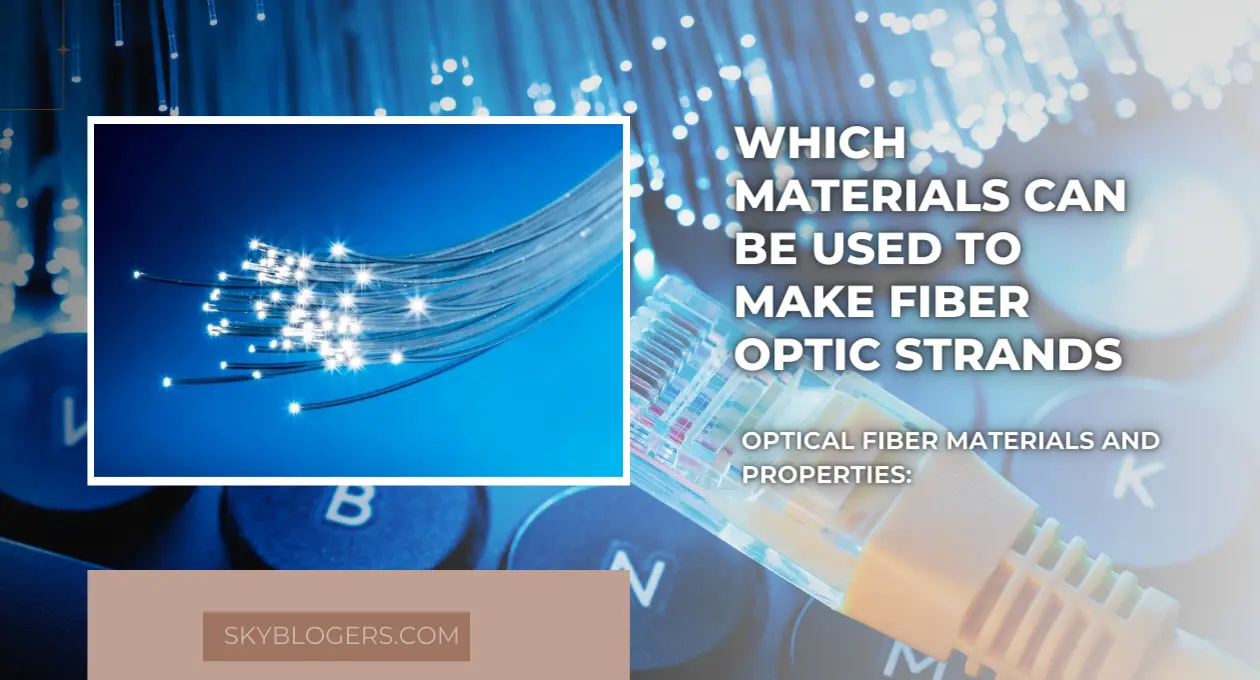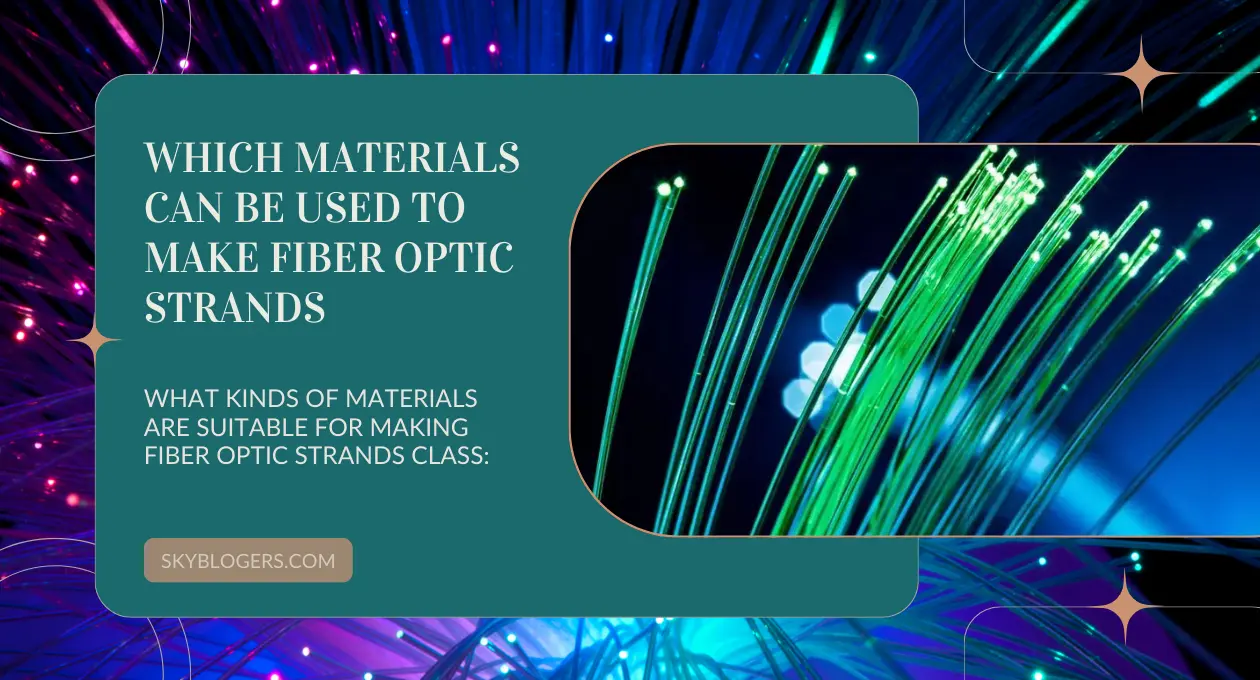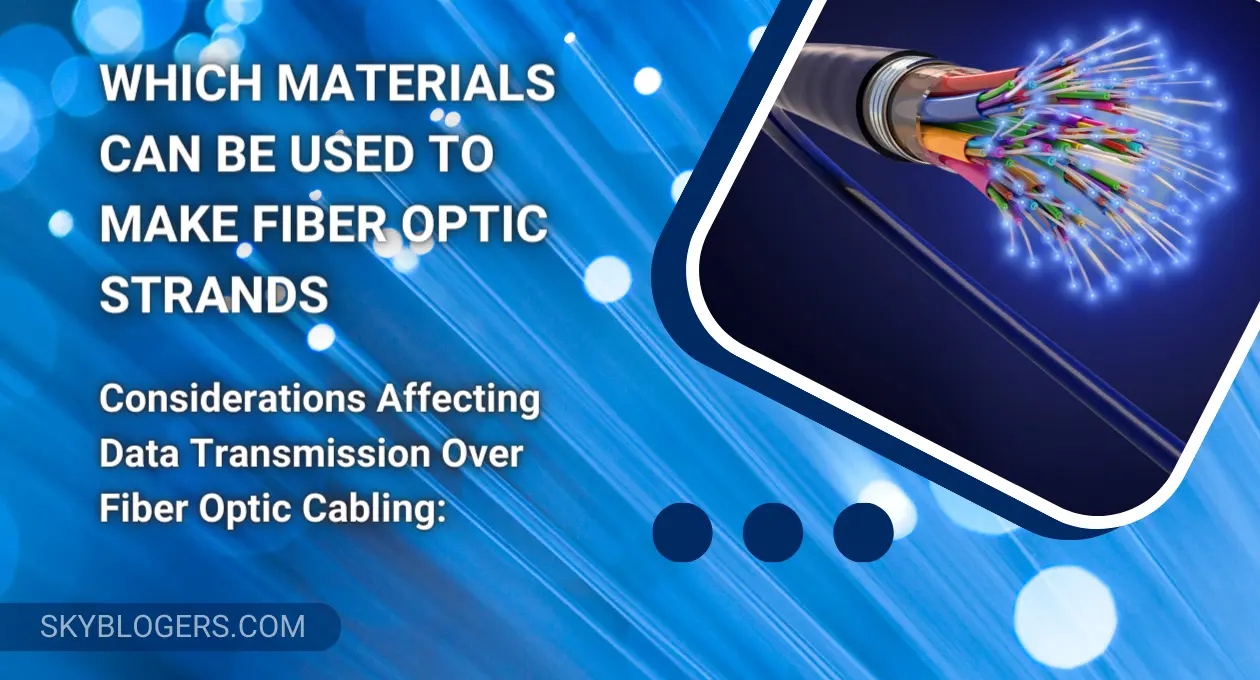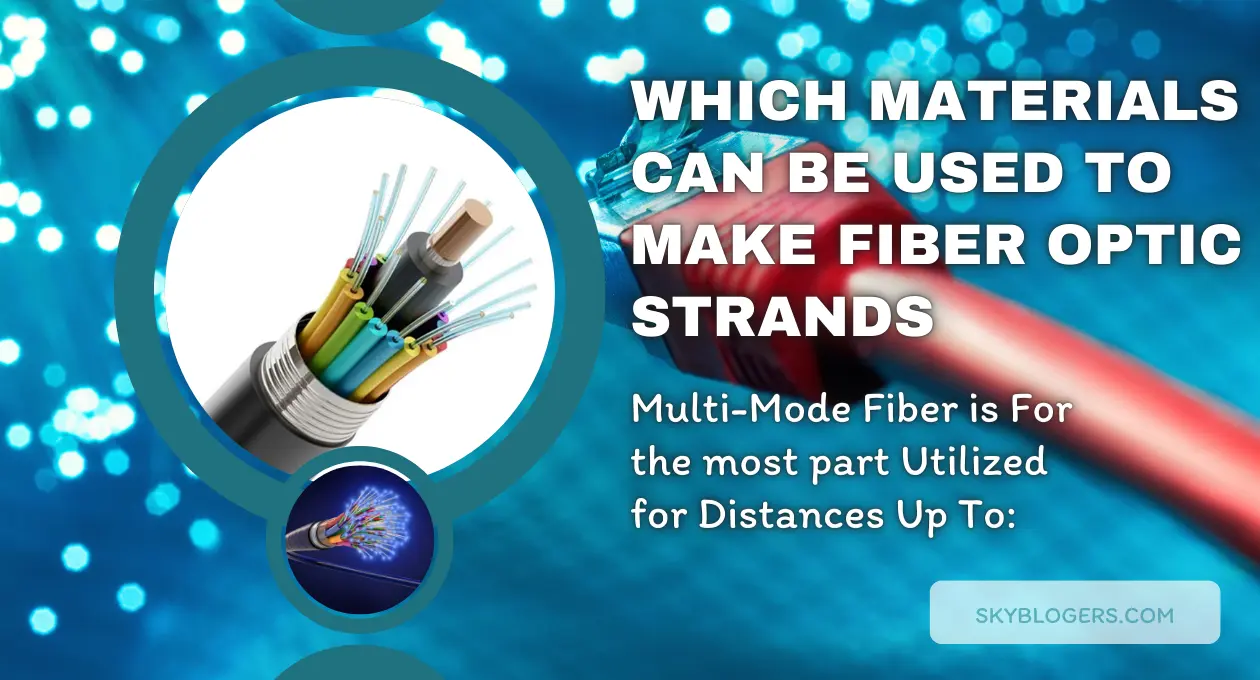In the consistently developing scene of innovation, fiber optics stands apart as a reference point of advancement, changing the manner in which we send information. Fundamental to the usefulness of fiber optic frameworks are the materials used to make the fragile strands that help data through beats of light. This blog will dig into the complexities of fiber optic materials, their properties, and the contemplations that influence information transmission over these momentous links.
Which materials can be used to make fiber optic strands is silica, on account of its excellent properties like insignificant sign weakening and high warm solidness. The core of the fiber, where light travels, is pure silica, which is frequently doped with other materials like germanium to improve its optical properties. These remarkable attributes make silica-based strands exceptionally proficient for significant distance information transmission, which is the reason they are the norm in the present media communications industry.
Nonetheless, the immaculateness of silica utilized in the manufacture cycle essentially influences the presentation of fiber optic links. Any pollutions can assimilate or disperse the light going through, bringing about signal misfortune and diminished loyalty over distances. Makers consequently utilize modern procedures to guarantee the silica’s virtue level is appropriate for the expected application, whether it’s for high velocity web, clinical imaging, or military interchanges.
While silica filaments are transcendent, late headways have prompted the investigation of new materials, as chalcogenide glasses and plastic optical strands (POF). These materials are chosen for explicit applications that require greater adaptability or different transmission properties. Chalcogenide glasses, for example, work well for infrared transmissions. POF, on the other hand, is more flexible and easier to install in home and automotive networks despite having a higher signal loss.
Fiber Optic Material:
The selection of materials that are used to build the optical fibers is at the heart of fiber optic technology. Silicon dioxide, regularly known as glass, is the essential material utilized because of its remarkable optical properties. The immaculateness and piece of the glass assume a critical part in deciding the effectiveness and execution of the fiber optic link.
To adjust the presentation attributes of optical filaments, dopants are brought into the silica glass. For example, phosphorus pentoxide is a common dopant that raises the refractive index. This makes it possible for light to stay in the core and increases signal strength. The cladding, which is the layer encompassing the center, is likewise produced using silica yet with a lower refractive record, frequently accomplished by doping with fluorine, to guarantee complete inner reflection vital for effective transmission.
The plan and assembling of fiber optic links require a profound comprehension of both the mechanical and the optical properties of the materials in question. Other than the right decision of glass and dopants, the defensive coatings assume a huge part. These coatings, normally made of acrylate polymers, safeguard the glass from natural dangers, dampness, and actual pressure, guaranteeing signals travel with security and dependability.
Progressions in innovation might actually present novel materials that outperform silica glass in effectiveness or address different transmission challenges. Improved materials that might make it possible to reduce signal loss, increase bandwidth, or discover novel ways to manipulate light are something that scientists are always looking for. Such developments could reclassify the ongoing limits of fiber optic innovation and make the way for extraordinary rates and abilities in correspondence frameworks.
Optical Fiber Materials and Properties:
The unique properties of the optical fiber materials make them ideal for data transmission. These incorporate low sign lessening, high data transfer capacity, and resistance to electromagnetic obstruction. Understanding these properties is significant for enhancing the exhibition of fiber optic frameworks.
Low sign lessening is one of the best properties of fiber optic materials, permitting signs to navigate tremendous distances with insignificant loss of respectability. Accordingly, telecom networks spreading over landmasses and seas to a great extent rely upon optical filaments. This is conceivable on the grounds that the center glass material is phenomenally straightforward, consequently, light endures almost no ingestion or dissipating as it races through the fiber.

Transfer speed limit is one more huge benefit presented by fiber optic innovation. The capacity to send at various frequencies (frequencies) all the while through a similar fiber — known as frequency division multiplexing (WDM) — incredibly grows the potential information throughput. The high-speed internet and data services that are now required by modern society are fueled by this multi-lane highway of light signals.
Ultimately, resistance to electromagnetic impedance (EMI) settles on optical filaments an ideal decision in conditions with elevated degrees of radio recurrence obstruction. This invulnerability is intrinsic on the grounds that optical transmission includes light, not electrons. In this way, information honesty is saved even in modern regions with huge EMI, like nearby high-power electrical hardware, making fiber optics an enduring spine of current information correspondence framework.
Which Materials Can Be Used to Make Fiber Optic Strands?
Glass or plastic make up the majority of fiber optic strands. Plastic fibers are utilized in short-distance communication due to their cost-effectiveness and flexibility, whereas glass fibers are utilized more frequently in long-distance communication due to their low signal loss.
Notwithstanding glass and plastic, analysts are exploring different avenues regarding more colorful materials for fiber optic strands. One such material is perfluorinated polymers, which display lower light corruption than ordinary plastic optical strands, offering better execution for rapid information organizations. Additionally, these materials are highly resistant to temperature changes and chemicals, making them suitable for harsh environments.
These advanced materials’ manufacturing process is more complicated and necessitates precise engineering. This intricacy is because of the need to keep a uniform refractive file along the whole length of the fiber to limit signal misfortune. In addition, the covering materials should be painstakingly chosen to match the development properties of the center and cladding to stay away from pressure actuated harms.
Future possibilities for fiber optics are not restricted to earthbound interchanges. Space applications, like satellite organizations and profound space correspondence, could benefit enormously from the innovation’s low weight and protection from unforgiving astronomical circumstances. Materials that can withstand high temperatures and radiation become crucial in this situation. Research in these fields could push the boondocks of correspondence framework to help interplanetary missions and past earth endeavors.
What Kinds of Materials Are Suitable for Making Fiber Optic Strands Class:
Various classes of materials add to the formation of fiber optic strands. Single-mode strands, with a little center size, are reasonable for significant distance correspondence. Conversely, multi-mode strands, with a bigger center, are liked for more limited distances.
In the domain of single-mode filaments, where accuracy is central, the material’s capacity to keep a steady center breadth is basic. The quality of the transmission can be affected by even the tiniest variation, which could result in greater loss or dispersion. To this end producers should control the cycle with demanding principles, frequently using refined estimation apparatuses to guarantee consistency and dependability in the fiber’s presentation.

The research into new materials for multi-mode fibers is also getting more intense as technology keeps getting better. Researchers are investigating photonics precious stones and empty main elements that could offer lower idleness and higher speed. These developments could prompt another wilderness where information can be sent with considerably more prominent effectiveness, opening up opportunities for continuous correspondence at exceptional scales.
The investigation of mixture materials additionally presents a thrilling potential for upgrading specific credits of fiber optic strands, like sturdiness and adaptability. By consolidating glass with different components, scientists expect to make filaments that are versatile in outrageous circumstances as well as simpler to deal with during establishment and support. These steps in material science could significantly help both the media communications industry and end-clients, by making more hearty and easy to understand correspondence organizations.
Which materials can be used to make fiber optic strands Brain:
The material selection is the heart of fiber optic communication. The strands’ capacity to effectively convey information is determined by their intricate design and composition. Silicon-based materials are acquiring conspicuousness as scientists investigate new roads for improving the capacities of fiber optics.
It is impossible to overstate the significance of silicon in the development of fiber optic technologies. Being the second most plentiful component on The planet, it gives an affordable base to making unadulterated glass filaments. As a result of advancements in silicon chemistry, optical signal loss has already been significantly reduced, making it possible to transmit data over greater distances without the need for repeaters.
As optical fiber innovation develops, the emphasis on manageable materials turns out to be progressively significant. The telecom industry is actively looking for eco-friendly alternatives that not only improve performance but also have a smaller negative impact on the environment. Biodegradable polymers and reused glass are potential applicants that can prompt greener creation processes without forfeiting quality.
Besides, with the beginning of the Quantum Web not too far off, conventional fiber optic materials might go through a change in perspective. Quantum correspondence requests another degree of accuracy and steadiness in fiber optics to dependably send quantum bits, or qubits, which might change secure correspondence. In order to keep fiber optics at the forefront of communication infrastructure, highly specialized materials designed to interface with quantum technologies must be developed.
Considerations Affecting Data Transmission Over Fiber Optic Cabling:
A few contemplations influence the productivity of information transmission over fiber optic links. Factors like twisting misfortune, scattering, and motion toward commotion proportion should be painstakingly considered during the plan and establishment of fiber optic frameworks to guarantee ideal execution.
Twisting misfortune, otherwise called bowing range limit, is a basic consider the exhibition of fiber optic links. Light can escape from the core of a cable when it is bent beyond its minimum bending radius, resulting in signal attenuation. Using improved cable designs that are less prone to bending losses, such as those with core materials that are more flexible or innovative cladding structures, and adhering to the appropriate installation procedures can both reduce the severity of this problem.

One more key test in fiber optic information transmission is scattering, where light heartbeats spread out over distance and time, possibly causing covering and a comparing loss of sign quality. Both modal and chromatic types of dispersion have distinct effects on both single-mode and multi-mode fibers. To battle this, engineers are participated in making materials and link plans that can lessen scattering impacts, subsequently empowering more clear and quicker correspondence.
A crucial quality metric for optical fiber data transmission is the signal-to-noise ratio (SNR). A higher SNR demonstrates a more clear transmission, with less foundation commotion obstructing the sign. Utilizing sophisticated amplifiers, utilizing higher-quality materials for the core and cladding, and optimizing the wavelength of the light source are all efforts that contribute to a communication network that is more dependable and effective. These improvements in fiber optic technology aim to increase SNR.
Three Materials Utilized for Making Optical Strands:
Notwithstanding customary glass strands, different materials like plastic and polymers are utilized for making optical filaments. Expanding the adaptability of fiber optic technology, these materials provide distinct advantages like adaptability, low cost, and suitability for particular applications.
Polymer optical fibers (POF) are gaining popularity in optics because of their versatility and ease of installation in applications. POFs are particularly helpful in conditions where tight twisting is unavoidable, as they are less delicate to bowing misfortunes than glass filaments. Furthermore, their innate sturdiness against actual shocks and vibrations makes them reasonable for modern and auto correspondence networks where power is a need.
While execution and material contemplations stay at the very front, the part of cost can’t be overlooked. To achieve widespread acceptance, fiber optic technologies must strike a balance between affordability and high-level functionality. Accordingly, the business is ceaselessly looking for techniques to smooth out assembling processes, decrease material costs, and work on establishment methodology, without settling on the quality and dependability of the information transmission.
The joining of fiber optic innovation into regular daily existence reaches out past telecom. Specialized fiber optic cables make it possible to perform advanced endoscopy diagnostics and minimally invasive surgeries in the medical field. Fiber optics offer creative lighting solutions and stunning visual effects in the design and entertainment industries. The significance of fiber optics as a revolutionary technology for the 21st century is emphasized by its adaptability.
Multi-Mode Fiber is For the most part Utilized for Distances Up To:
Shorter distances are typically served by multi-mode fibers, which have a larger core diameter. These strands are appropriate for applications inside structures and server farms, giving high transmission capacity to neighborhood (LANs) and brief distance correspondence.
The development of multi-mode fiber optics becomes a major area of research and engineering as the need for more bandwidth and improved data transmission protocols grows. The improvement of OM5, a wideband multi-mode fiber, represents this movement. OM5 is intended to help wave division multiplexing (WDM), permitting different signs to navigate a similar fiber strand while essentially upgrading the general information limit and speed inside the predetermined short-range distances.
Fiber optics have been put to new use in environmental monitoring and evaluation of ecological systems. Fiber optic sensors, delicate to minute changes in temperature and strain, are presently essential in distinguishing ecological boundaries, which is basic for the investigation of environmental change and normal asset the board. These sensors are popular because they are not intrusive and can provide real-time data in a variety of terrains and conditions.
The fate of fiber optics likewise lies in its mix with prospering advancements like 5G organizations, the Web of Things (IoT), and brilliant city framework. The backbone of smart cities will be the combination of fiber optics’ high speed and 5G’s low latency, making it possible for an ever-expanding web of connected devices, from autonomous vehicles to advanced public safety systems, to communicate seamlessly.
FAQs:
When making optical fibers, what is the primary benefit of using plastic or polymer materials?
The fundamental benefit is adaptability, as these materials are less inclined to bowing misfortunes and more strong against actual shocks and vibrations.
How are single-mode and multi-mode fibers affected differently by dispersion?
Scattering causes covering of light heartbeats in multi-mode filaments, though it prompts a widening of the light heartbeats in single-mode strands. This can bring about mutilation and loss of sign quality, especially over significant distances.
When data is transmitted through optical fiber, how is the signal-to-noise ratio (SNR) improved?
Motion toward clamor proportion can be further developed through different strategies like utilizing modern speakers, greater materials for the center and cladding, and upgrading the light source’s frequency.
What role does fiber optics play in the infrastructure of smart cities?
Fiber optics assumes a critical part in empowering rapid correspondence between a steadily developing trap of associated gadgets in brilliant urban communities, like independent vehicles and public wellbeing frameworks.

Conclusion:
Understanding the which materials can be used to make fiber optic strands is essential for maximizing the potential of high-speed data transmission in the ever-expanding field of technology. Whether it’s the glass or plastic piece, the properties of these materials, or the contemplations influencing information transmission, every perspective adds to the consistent progression of data through the complicated snare of fiber optic links. As innovation keeps on progressing, so too will the materials and plans that support the universe of fiber optics.
For more amazing information keep visiting SkyBlogers.

